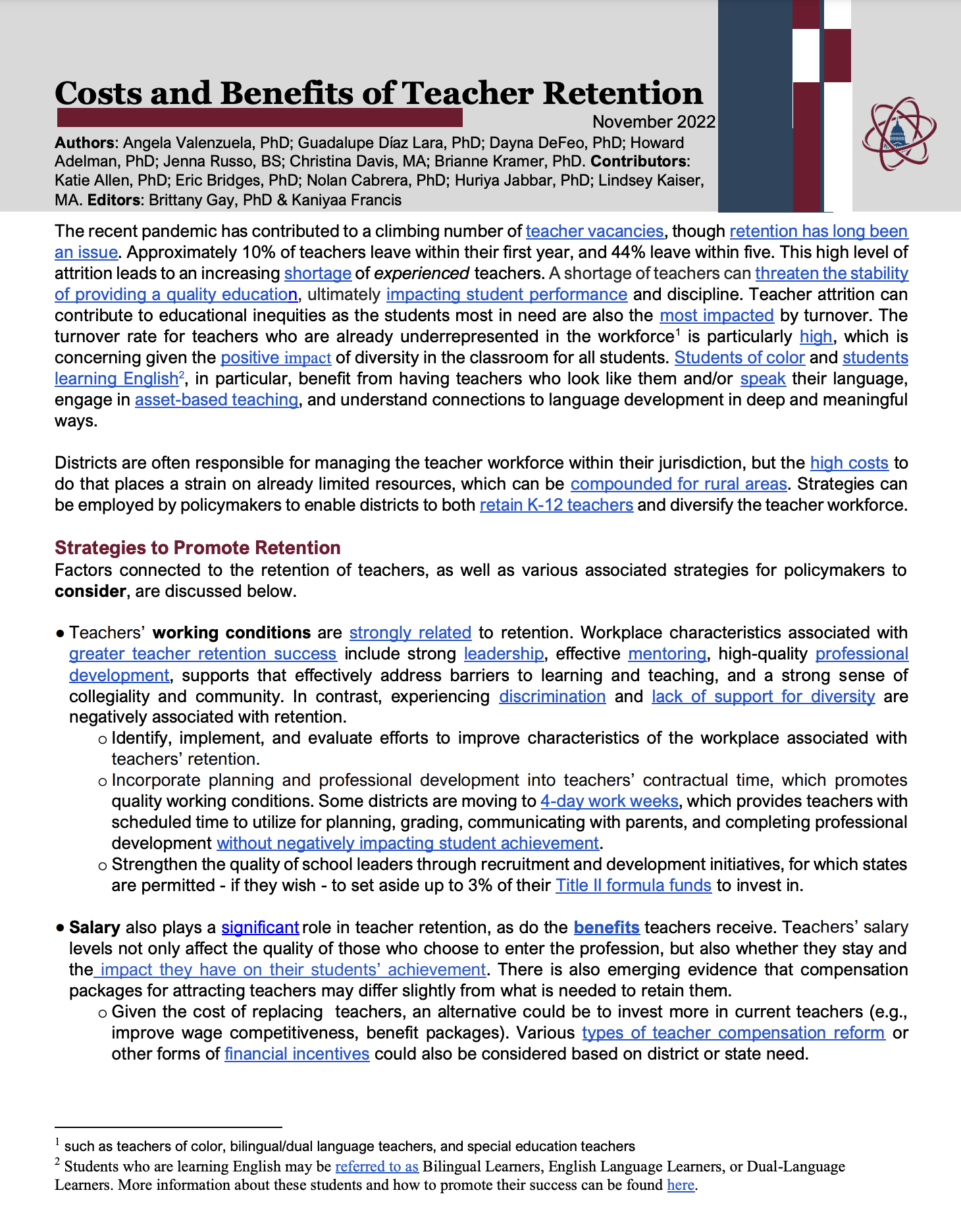
The recent pandemic has contributed to a climbing number of teacher vacancies, though retention has long been an issue. Approximately 10% of teachers leave within their first year, and 44% leave within five. This high level of attrition leads to an increasing shortage of experienced teachers. A shortage of teachers can threaten the stability of providing a quality education, ultimately impacting student performance and discipline. Teacher attrition can contribute to educational inequities as the students most in need are also the most impacted by turnover. The turnover rate for teachers who are already underrepresented in the workforce[1] is particularly high, which is concerning given the positive impact of diversity in the classroom for all students. Students of color and students learning English[2], in particular, benefit from having teachers who look like them and/or speak their language, engage in asset-based teaching, and understand connections to language development in deep and meaningful ways.
Districts are often responsible for managing the teacher workforce within their jurisdiction, but the high costs to do that places a strain on already limited resources, which can be compounded for rural areas. Strategies can be employed by policymakers to enable districts to both retain K-12 teachers and diversify the teacher workforce.
Strategies to Promote Retention
Factors connected to the retention of teachers, as well as various associated strategies for policymakers to consider, are discussed below.
- Teachers’ working conditions are strongly related to retention. Workplace characteristics associated with greater teacher retention success include strong leadership, effective mentoring, high-quality professional development, supports that effectively address barriers to learning and teaching, and a strong sense of collegiality and community. In contrast, experiencing discrimination and lack of support for diversity are negatively associated with retention.
- Identify, implement, and evaluate efforts to improve characteristics of the workplace associated with teachers’ retention.
- Incorporate planning and professional development into teachers’ contractual time, which promotes quality working conditions. Some districts are moving to 4-day work weeks, which provides teachers with scheduled time to utilize for planning, grading, communicating with parents, and completing professional development without negatively impacting student achievement.
- Strengthen the quality of school leaders through recruitment and development initiatives, for which states are permitted – if they wish – to set aside up to 3% of their Title II formula funds to invest in.
- Salary also plays a significant role in teacher retention, as do the benefits teachers receive. Teachers’ salary levels not only affect the quality of those who choose to enter the profession, but also whether they stay and the impact they have on their students’ achievement. There is also emerging evidence that compensation packages for attracting teachers may differ slightly from what is needed to retain them.
- Given the cost of replacing teachers, an alternative could be to invest more in current teachers (e.g., improve wage competitiveness, benefit packages). Various types of teacher compensation reform or other forms of financial incentives could also be considered based on district or state need.
-
- Other individual-level factors, such as a teacher’s sense of achievement, also matter. Teachers who believe their work is important and impactful are more likely to remain in the teaching profession. A growing body of research documents the role that community-based teachers play in promoting a sense of achievement.
- Cultivate school environments where mentorship relationships can be easily formed and accountability for one another is widely promoted, which can be particularly beneficial for teachers of color.
- Reflect on how prohibitive the requirements to become a teacher are and consider whether or how pathways could be developed to expand the teaching pipeline to individuals with vested interests in the education of their community. Examples include recruiting teacher candidates when they are students (e.g., pre-collegiate) and creating local entry points into teaching through partnerships between K-12 and universities, community-based organizations, and education policymakers.
- Other individual-level factors, such as a teacher’s sense of achievement, also matter. Teachers who believe their work is important and impactful are more likely to remain in the teaching profession. A growing body of research documents the role that community-based teachers play in promoting a sense of achievement.
Additional Resources
- Baker (2017). How money matters for schools.
- Carver-Thomas (2018). Diversifying the teaching profession: How to recruit and retain teachers of color.
- Castro et al. (2022). Teacher retention policy coherence: An analysis of policies and practices across federal, state, and division levels.
- Holmes et al. (2019). Rethinking retention in hard-to-staff schools.
- Podolsky et al. (2016). Solving the teacher shortage: How to attract and retain excellent educators.
- Washington State Institute for Public Policy (WSIPP) benefit-cost results for PK-12 education.
Footnotes
[1] such as teachers of color, bilingual/dual language teachers, and special education teachers
[2] Students who are learning English may be referred to as Bilingual Learners, English Language Learners, or Dual-Language Learners. More information about these students and how to promote their success can be found here.
The Research-to-Policy Collaboration (RPC) works to bring together research professionals and public officials to support evidence-based policy. Please visit their website to learn more.
Key Information
RPC Website
Research-to-Policy Collaboration
Publication DateNovember 1, 2022
Topic Area(s)Education and Child Development, Equity, Economy and Entrepreneurship
Resource TypeWritten Briefs
Share This Page
The recent pandemic has contributed to a climbing number of teacher vacancies, though retention has long been an issue. Approximately 10% of teachers leave within their first year, and 44% leave within five. This high level of attrition leads to an increasing shortage of experienced teachers. A shortage of teachers can threaten the stability of providing a quality education, ultimately impacting student performance and discipline. Teacher attrition can contribute to educational inequities as the students most in need are also the most impacted by turnover. The turnover rate for teachers who are already underrepresented in the workforce[1] is particularly high, which is concerning given the positive impact of diversity in the classroom for all students. Students of color and students learning English[2], in particular, benefit from having teachers who look like them and/or speak their language, engage in asset-based teaching, and understand connections to language development in deep and meaningful ways.
Districts are often responsible for managing the teacher workforce within their jurisdiction, but the high costs to do that places a strain on already limited resources, which can be compounded for rural areas. Strategies can be employed by policymakers to enable districts to both retain K-12 teachers and diversify the teacher workforce.
Strategies to Promote Retention
Factors connected to the retention of teachers, as well as various associated strategies for policymakers to consider, are discussed below.
- Teachers’ working conditions are strongly related to retention. Workplace characteristics associated with greater teacher retention success include strong leadership, effective mentoring, high-quality professional development, supports that effectively address barriers to learning and teaching, and a strong sense of collegiality and community. In contrast, experiencing discrimination and lack of support for diversity are negatively associated with retention.
- Identify, implement, and evaluate efforts to improve characteristics of the workplace associated with teachers’ retention.
- Incorporate planning and professional development into teachers’ contractual time, which promotes quality working conditions. Some districts are moving to 4-day work weeks, which provides teachers with scheduled time to utilize for planning, grading, communicating with parents, and completing professional development without negatively impacting student achievement.
- Strengthen the quality of school leaders through recruitment and development initiatives, for which states are permitted – if they wish – to set aside up to 3% of their Title II formula funds to invest in.
- Salary also plays a significant role in teacher retention, as do the benefits teachers receive. Teachers’ salary levels not only affect the quality of those who choose to enter the profession, but also whether they stay and the impact they have on their students’ achievement. There is also emerging evidence that compensation packages for attracting teachers may differ slightly from what is needed to retain them.
- Given the cost of replacing teachers, an alternative could be to invest more in current teachers (e.g., improve wage competitiveness, benefit packages). Various types of teacher compensation reform or other forms of financial incentives could also be considered based on district or state need.
-
- Other individual-level factors, such as a teacher’s sense of achievement, also matter. Teachers who believe their work is important and impactful are more likely to remain in the teaching profession. A growing body of research documents the role that community-based teachers play in promoting a sense of achievement.
- Cultivate school environments where mentorship relationships can be easily formed and accountability for one another is widely promoted, which can be particularly beneficial for teachers of color.
- Reflect on how prohibitive the requirements to become a teacher are and consider whether or how pathways could be developed to expand the teaching pipeline to individuals with vested interests in the education of their community. Examples include recruiting teacher candidates when they are students (e.g., pre-collegiate) and creating local entry points into teaching through partnerships between K-12 and universities, community-based organizations, and education policymakers.
- Other individual-level factors, such as a teacher’s sense of achievement, also matter. Teachers who believe their work is important and impactful are more likely to remain in the teaching profession. A growing body of research documents the role that community-based teachers play in promoting a sense of achievement.
Additional Resources
- Baker (2017). How money matters for schools.
- Carver-Thomas (2018). Diversifying the teaching profession: How to recruit and retain teachers of color.
- Castro et al. (2022). Teacher retention policy coherence: An analysis of policies and practices across federal, state, and division levels.
- Holmes et al. (2019). Rethinking retention in hard-to-staff schools.
- Podolsky et al. (2016). Solving the teacher shortage: How to attract and retain excellent educators.
- Washington State Institute for Public Policy (WSIPP) benefit-cost results for PK-12 education.
Footnotes
[1] such as teachers of color, bilingual/dual language teachers, and special education teachers
[2] Students who are learning English may be referred to as Bilingual Learners, English Language Learners, or Dual-Language Learners. More information about these students and how to promote their success can be found here.
The Research-to-Policy Collaboration (RPC) works to bring together research professionals and public officials to support evidence-based policy. Please visit their website to learn more.

Key Information
RPC Website
Research-to-Policy Collaboration
Publication DateNovember 1, 2022
Topic Area(s)Education and Child Development, Equity, Economy and Entrepreneurship
Resource TypeWritten Briefs
Share This Page
LET’S STAY IN TOUCH
Join the Evidence-to-Impact Mailing List
Keep up to date with the latest resources, events, and news from the EIC.




